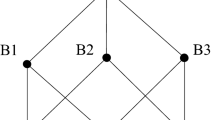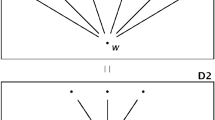Abstract
According to strong composition as identity (CAI), the logical principles of one–one and plural identity can and should be extended to the relation between a whole and its parts. Otherwise, composition would not be legitimately regarded as an identity relation. In particular, several defenders of strong CAI have attempted to extend Leibniz’s Law to composition. However, much less attention has been paid to another, not less important feature of standard identity: a standard identity statement is true iff its terms are coreferential. We contend that, if coreferentiality is dropped, indiscernibility is no help in making composition a genuine identity relation. To this aim, we analyse as a case study Cotnoir’s theory of general identity, in which indiscernibility is obtained thanks to a revisionary semantics and true identity statements are allowed to connect non-coreferential terms. We extend Cotnoir’s strategy for indiscernibility to the relation of comaternity, and we show that, neither in the case of composition nor in that of comaternity, indiscernibility contibutes to show that they are genuine identity relations. Finally, we compare Cotnoir’s approach with other versions of strong CAI endorsed by Wallace, Bøhn, and Hovda, and canvass the extent to which they violate coreferentiality. The comparative analysis shows that, in order to preserve coreferentiality, strong CAI is forced to adopt a non-standard semantic treatment of the singular/plural distinction.
Similar content being viewed by others
Notes
According to Lewis’s so-called mereological monism [as it has been labeled by Fine (1994)], mereology is the general, exhaustive theory of ontological constitution. We shall not discuss this assumption. Throughout the paper, composition is always identified with mereological fusion.
See in particular Baxter (1999).
Reflexivity and Leibniz’s Law are actually sufficient to identify a unique relation. See Quine (1961).
As it is common in the literature about plural quantification, “double” signs such as \(xx , yy , zz\) etc. are plural variables.
The example is discussed in Oliver and Smiley (2013, 3).
Being non-symmetric, composition is not strictly speaking a subrelation of being the same portion of reality, but, for every \(xx\) and every \(y\), if \(xx\) compose \(y\), then—according to the intuition laying behind CAI—\(xx\) and \(y\) are the same portion of reality. The implication in the opposite direction—that is the claim that if \(xx\) and \(y\) are the same portion of reality, then \(xx\) compose \(y\)—can also be defended. See Sider (2007, 9–12), and Bøhn (2014).
In a footnote (no. 12) Cotnoir deflates his commitment to atoms, suggesting that “propertied spacetime points” could replace mereological atoms. It is not clear at this stage (Cotnoir aims to explore this alternative in future work) how this could work if mereology is expected to involve also abstract entities.
In another part of Cotnoir (2013), the denotation of a singular term (a chunk) is said to be included in other sets (see the definitions of “is-covered-by” and “is-part-of”, p. 305).
The ways of dividing the domain of atoms to which the predicates are relativized are not partitions but “covers”: in a partition, the sets of atoms are disjoint, while in a cover they are allowed to overlap. This distinction is important in Cotnoir’s semantic analysis of collective and cumulative predication (Cotnoir 2013, 309), but nothing in our analysis depends on it.
See Black (1951).
This does not mean that the attempt to defend the principle of identity of indiscernibles by insisting that the spheres are, after all, numerically identical is completely worthless. See O’Leary-Hawthorne (1995) and Della Rocca (2005). But, within this attempt, indiscernibility can not be adduced as an evidence of genuine identity.
For example: “On my proposal, plural expressions only ever refer to a portion of reality under a way of counting.” (Cotnoir 2013, 316)
“The floor” denotes this set also in Cotnoir’s present formulation.
The specification “at least” is required because, as already noted at no. 12, the ways in which atoms are grouped in sets are, according to Cotnoir, covers and not partitions, i.e. they are allowed to overlap. As a consequence, the number of allowed sets of atoms could increase dramatically.
The worries about semantic revisionism could be deflated if these semantic tools were limited to a mereological calculus, or to some other formal language built on purpose. But this does not seem to be the case for Cotnoir, whose overall defense of CAI contemplates, for example, the identification of a way to express many-one identity statements in English, with the help of free relatives (Cotnoir 2013, 298–300).
Rayo (2006, 226–228). Already at the second level, it is hard to find examples of saturated terms in natural language. See Linnebo and Nicolas (2008) and Oliver and Smiley (2013, 127–128) for some candidates. For what concerns GI, as we are going to see, there is no need to go beyond the second level.
Perhaps some worries could be raised about the predicates needed to “build” the various terms. In Rayo (2006), hyperplurals are syntactically built from predicates and saturators. In GI, the terms would be standard singular and plural referential expressions, and different levels of plurality should concern only the semantic level. This means that the predicates could not be easily detected within the terms themselves of a GI statement. Perhaps, we could envisage complex predicates such as “be an atomic constituent of the floor” for the singular expression “the floor”, “be an atomic constituent of at least a tile of the floor” for “the tiles”, and “be an atomic constituent of at least a square of the floor” for “the squares”.
A preceding footnote (no. 2, pp. 143–144) clarifies that the value is the referent.
“Times” are not temporal instants, but different instances of the reference relations.
Some dissonant remarks in Hovda’s unpublished work could suggest a way to restore coreferientiality. Hovda writes that “when we refer to John, we refer to those atoms [the atoms composing John] collectively. We also refer to Johnleft and Johnright, collectively. These are just many ways of describing the same fact.” (p. 14) This could mean that, e.g., both “John” and “\(J_l\) and \(J_r\)” refer both to John and to John’s two halves. If properly developed (would this be a case of ambiguous reference?), this approach could lead to yet another highly non-standard treatment of semantic number and allow Hovda to respect the Coreferentiality Constraint. However, when discussing an example of hybrid identity statements, we have seen that he writes in so many words that “\(J_l\) and \(J_r\)” “does not refer to John” (p. 15), preferring a standard treatment of semantic number over this possible way to preserve coreferentiality. This missed opportunity seems to be an unresolved tension in Hovda’s manuscript.
References
Baxter, D. (1999). The discernibility of identicals. Journal of Philosophical Research, 24, 37–55.
Black, M. (1951). The identity of indiscernibles. Mind, 61(242), 153–164.
Bøhn, E. (2009). Composition as identity: A study in ontology and philosophical logic. Ph.D. thesis, University of Massachusetts, Amherst
Bøhn, E. (2014). Unrestricted composition as identity. In D. Baxter & A. Cotnoir (Eds.), Composition as identity. Oxford: Oxford University Press.
Cotnoir, A. (2013). Composition as general identity. Oxford Studies in Metaphysics, 8, 295–322.
Cotnoir, A. (2014). Composition as identity: Framing the debate. In D. Baxter & A. Cotnoir (Eds.), Composition as identity (pp. 3–23). Oxford: Oxford University Press.
Daly, C., & Liggins, D. (2010). In defence of error theory. Philosophy, 149, 209–230.
Della Rocca, M. (2005). Two spheres, twenty spheres, and the identity of indiscernibles. Pacific Philosophical Quarterly, 86(4), 480–492.
Fine, K. (1994). Compounds and aggregates. Noûs, 28(2), 137–158.
Hawley, K. (2013). Cut the pie any way you like? Oxford Studies in Metaphysics, 8, 323–341.
Hovda, P. (2005). Two defenses of composition as identity. Unpublished manuscript.
Lewis, D. (1991). Parts of classes. Oxford: Blackwell.
Liggins, D. (2008). Nihilism without self-contradiction. Philosophy, 83, 177–196.
Linnebo, Ø., & Nicolas, D. (2008). Superplurals in English. Analysis, 68(299), 186–197.
McKay, T. (2006). Plural predication. New York: Oxford University Press.
O’Leary-Hawthorne, J. (1995). The bundle theory of substance and the identity of indiscernibles. Analysis, 55(3), 191–196.
Oliver, A., & Smiley, T. (2013). Plural logic. Oxford: Oxford University Press.
Quine, W. (1961). Reply to Professor Marcus. Synthese, 13(4), 323–330.
Rayo, A. (2006). Beyond plurals. In A. Rayo & G. Uzquiano (Eds.), Absolute generality (pp. 220–254). Oxford: Oxford University Press.
Sider, T. (2007). Parthood. Philosophical Review, 116(1), 51–91.
Uzquiano, G. (2004). Plurals and simples. The Monist, 87(3), 429–451.
Wallace, M. (2009). Composition as identity. Ph.D. thesis, University of North Carolina, Chapel Hill.
Wallace, M. (2011). Composition as identity: Part 1. Philosophy Compass, 6(11), 804–816.
Wallace, M. (2011b). Composition as identity: Part 2. Philosophy Compass, 6(11), 817–827.
Yi, B.-U. (1999). Is mereology ontologically innocent? Philosophical Studies, 93(2), 141–160.
Author information
Authors and Affiliations
Corresponding author
Rights and permissions
About this article
Cite this article
Carrara, M., Lando, G. Composition, Indiscernibility, Coreferentiality. Erkenn 81, 119–142 (2016). https://doi.org/10.1007/s10670-015-9732-3
Received:
Accepted:
Published:
Issue Date:
DOI: https://doi.org/10.1007/s10670-015-9732-3




